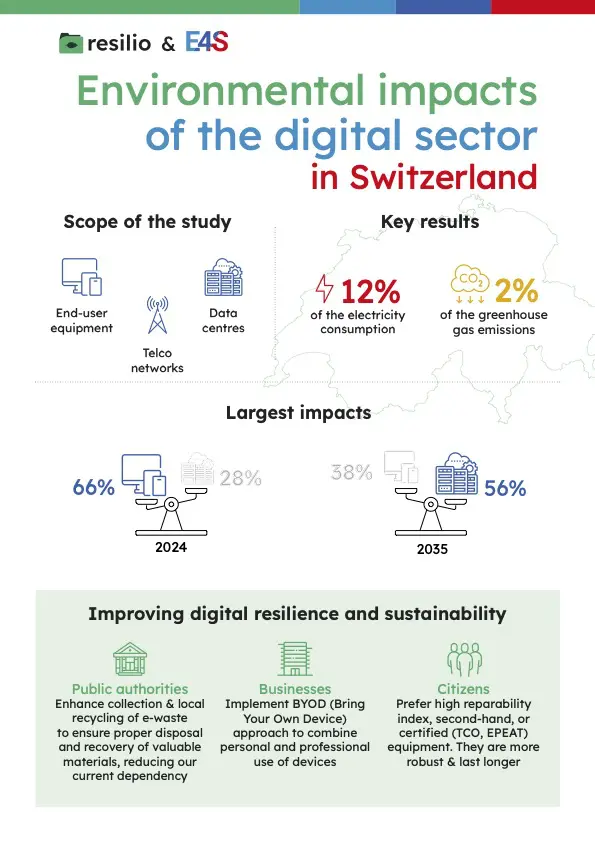
Environmental impacts of the ICT sector in Switzerland
Executive Summary
The study was conducted by the impact startup Resilio in partnership with the Enterprise for Society Center and 20 other organisations.
The role of human activities in environmental crises is now undeniable. In 2016, Switzerland signed the Paris Agreement along with 196 nations¹ and continued to set other ambitious targets.
Digital technology plays a complex role in environmental matters. While it seems immaterial, it notably contributes to pollution and resource depletion. It is crucial to assess and mitigate its environmental impacts to ensure a more sustainable future.
To answer this need, many Swiss organisations and institutions conducted a study on Information and Communication Technologies (ICT) in Switzerland aiming to:
- Identify the main sources of impacts;
- Inform policy-makers and motivate them to take action;
- Contribute to raising awareness among Swiss citizens and businesses.
The study’s methodology is based on Life Cycle Assessment (LCA), used to assess the environmental impacts of a system through its life cycle and considering many environmental impacts. The perimeter studied is the entirety of digital equipment and infrastructures in use in Switzerland, for personal and professional use, in 2024 and projections in 2035.
The key results from this study show that ICT infrastructures contribute to 2% of the total Swiss consumption-based CO₂ emissions¹ and 12% of total electricity consumption in 2024. Furthermore, the footprint will increase rapidly until 2035. These trends are due to the increase of the population and the growth of new usages (generative AI, virtual reality, etc.). Metals and minerals resource use plays a critical role. There is a specific concern about the rising demand for electronics.
End-user equipment is the main driver of environmental impacts in 2024. However, the trends until 2035 will reverse as data centres and networks footprints will strongly increase and concentrate most of the impacts by 2035.
It is essential to act upon these conclusions to ensure the sustainability of the digital transformation. The recommendations presented in this study are structured around three objectives:
1. Decrease the need for new devices manufacturing: avoiding manufacturing new equipment whenever it is possible by extending the lifespan of devices;
2. Design and manufacture more efficient equipment and infrastructures: manufacture less resource-intensive devices, by practising sobriety and circularity;
3. Arbitrate digital use: critically assess and moderate the use of digital technologies to ensure they meet genuine needs without excess.
This white paper is authored by Louis Guégan, Louise Aubet, Léa Bitard (Resilio Ltd).
Study webpage: sustainableit.ch
